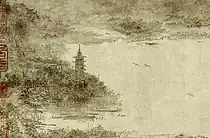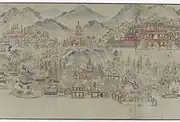Leifeng Pagoda
| Leifeng Pagoda | |||||||
|---|---|---|---|---|---|---|---|
.jpg.webp) Aerial view of Leifeng Pagoda | |||||||
| Chinese | 雷峰塔 | ||||||
| |||||||
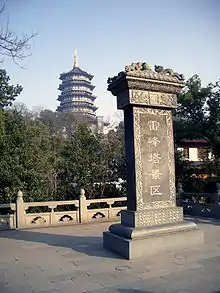
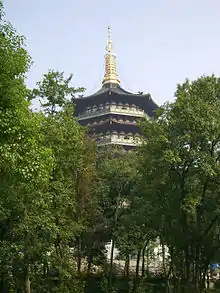



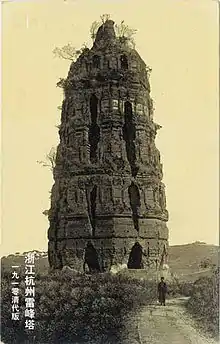
.jpg.webp)
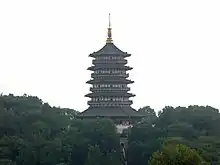
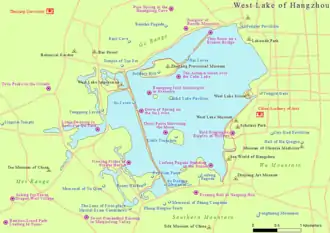

Leifeng Pagoda is a five story tall tower with eight sides, located on Sunset Hill south of the West Lake in Hangzhou, Zhejiang, China. Originally constructed in the year AD 975, it collapsed in 1924 but was rebuilt in 2002. Since then, it has become a popular tourist attraction. As a protected cultural heritage unit, the Ten Views of West Lake - Leifeng Sunset consists of the Sunset Hill, Leifeng Pagoda, the Imperial Monument (rebuilt in recent years) and the courtyard and other buildings.[1]
History
Original
The original pagoda was built in 975 AD, during the Five Dynasties and Ten Kingdoms period, at the order of King Zhongyi (Qian Chu) of Wuyue for his favorite concubine, Consort Huang. The Leifeng Pagoda was an octagonal,[2] five-story structure built of brick and wood with a base built of bricks.
During the Ming dynasty, Japanese pirates attacked Hangzhou. Suspecting the pagoda contained weapons, they burned its wooden elements, leaving only the brick skeleton, which can be seen from Ming paintings of the West Lake.[3]
Leifeng Pagoda was one of the ten sights of the West Lake because of the Legend of the White Snake.[4] In the Chinese folk story “The Legend of White Snake”,[5] the monk Fahai deceived Xu Xian to Jinshan, and the White Lady ran into Jinshan to rescue Xu Xian, and was suppressed by Fahai under the Leifeng Pagoda.[6]
Later, due to a superstition that the bricks from the tower could repel illness or prevent miscarriage, many people stole bricks from the tower to grind into powder. On the afternoon of September 25, 1924, the pagoda finally collapsed due to disrepair.[7] At that time Lu Xun wrote two articles commenting on this event, using the pagoda to symbolize the collapse of pedantic traditional Chinese thoughts and expressing his hope for the future society.[8][9] Xu Zhimo and Yu Pingbo also wrote poems and articles to commemorate the pagoda.[10]
Reconstruction
In the 13th year of the Republic of China (1924), the brick tower of the Leifeng Pagoda fell into disrepair on 25 September and only the ruins remain.[7]
In October 1999, the provincial and municipal governments decided to rebuild Leifeng Pagoda on top of the ruins of the old one. The new pagoda opened on 25 October 2002. It is composed of a 1400 tonne steel structure with 200 tonnes of copper parts. It contains four sightseeing elevators, and modern amenities such as air conditioning, television, and speakers. At the entrance of the pagoda, there are two autonomous escalators to carry visitors to the base of the pagoda.[11]
The original base of the pagoda is kept in good condition, as well as the artifacts discovered in the underground chamber.
Historical development
In the second year of Taiping Xingguo era of the Northern Song Dynasty (977 AD),[12] the king of Wu Yue, Qian Chu, built a 7-storey tower named Huangfei[13] Pagoda to offer Buddha's relics and pray for national peace and prosperity. Later, it was renamed as Leifeng Pagoda due to its location on Leifeng (Xizhao Mountain).
In the second year of Xuanhe in the Northern Song Dynasty (1120 AD),Leifeng Pagoda was destroyed by war and fire.
In the seventh year of the Qianlong era of the Southern Song Dynasty (1171), Master Zhiyou of Buddhism initiated the renovation of Leifeng Pagoda, only renovation to five floors.[14]
During the Ming Jiajing period, the wooden eaves of the Leifeng Pagoda were destroyed by war, leaving only the reddish-brown brick tower core.[15]
In the early Qing Dynasty, the Lei Feng Pagoda was still a reddish-brown brick tower. During his southern tour, Emperor Kangxi gave the name"Lei Feng Evening Glow"[16][17] to it.
In the late Qing Dynasty, the Lei Feng Pagoda had fallen into disrepair due to its age, and the ignorant people had stolen bricks, weakening the foundation of the tower.[15]
On September 25, 1924, in the thirteenth year of the Republic of China, the Lei Feng Pagoda collapsed due to excessive brick theft and excavation, as well as nearby construction work causing vibrations at the site.[18]
In the year 1935, the Chinese architect Liang Sicheng put forward the idea of rebuilding the Leifeng Pagoda and suggested restoring it to its original state.[15]
In May 1983, China's State Council approved the plan for the reconstruction of the Leifeng Pagoda project in the Hangzhou City Master Plan.[15]
In 1988, Zhejiang Travel Future Research Association, Hangzhou Tourism Economics Association, Hangzhou Garden Society, Hangzhou Buddhist Association, Lingyin Temple, Zhejiang Overseas Chinese Association, Hangzhou Overseas Chinese Association, Overseas Chinese Hotel, Qianjiang Evening News, Jiangnan Travel Newspaper, etc. jointly initiated to organize the Leifeng Pagoda Reconstruction Promotion Association in the form of a civil organization and drafted the reconstruction of the origin, but due to many reasons still could not be put into practice.[15]
In July 1999, the Zhejiang Provincial Government and Hangzhou Municipal Government approved the reconstruction of Leifeng Pagoda to be officially included in the agenda.[19]
On December 16, 2000, the reconstruction project of Leifeng Pagoda was officially opened.[20]
On October 25, 2002, the reconstruction of Leifeng Pagoda was completed and officially opened to the public.[21]
Architectural pattern
Overview
Leifeng Pagoda was originally a brick-wood structured tower in the style of a pavilion-like tower, with a wooden eave gallery (subsidiary steps, waist eave, flat seat, railing, etc.) outside and a brick tower body inside that can be climbed. There are stone carvings of the "Avatamsaka Sutra" on the tower wall. According to photos taken during the period of the Republic of China, the height of the original tower's bottom layer was about 12 meters, and the height of each of the other layers was about 8 meters, for a total height of about 50 meters. The pagoda top still has a cylindrical brick-paved stupa base.[11]
Stylobate
From 2000 to 2001, the Zhejiang Provincial Institute of Cultural Relics and Archaeology conducted a clearance and excavation of the Leifeng Pagoda site. The identified remains of the site mainly include the tower foundation, underground palace, remaining tower body, and some peripheral buildings (such as monk rooms and roads). The tower foundation and tower body are both equilateral octagons. The tower foundation is a natural hill platform with brick and stone on the outer edge, which was flattened and modified. Each side is 17 meters long and the diagonal is 41 meters, with a height of 1.2-2.5 meters above the ground.[22]
The base of the pagoda is built with stone-made Sumeru pedestal. As the terrain is higher in the west and lower in the east, a double-layered Sumeru pedestal is used on the eastern side, while a single-layered one is adopted on the western side. Carvings of Sumeru Mountain and the sea waves, symbolic of Buddhism's "Nine Mountains and Eight Seas," can be seen on the eastern pedestal, while an overturned lotus is carved on the western pedestal. A secondary platform runs between the outer edge of the pagoda base and the Sumeru pedestal. Judging from the 24 pieces of limestone square column tops excavated from the outer edge of the pagoda base, each face of the original secondary platform had four columns and three bays, with a width of about 5 meters for both the primary and secondary bays, and a depth of about 5.8 meters.[22]
Only the lowest level of the tower remains, with an average height of 3–5 meters. It has a sleeve-corridor structure, with the outer sleeve, corridor, inner sleeve, and core chamber arranged from outer to inner, similar to the Tiger Hill Pagoda in Suzhou and the Liuhe Pagoda in Hangzhou. This is a typical Buddhist tower style from the late Wu and Yue dynasties. The outer sleeve has a length of 10 meters and a diameter of 25 meters, making it the largest existing tower among the Five Dynasties. It is 4.2 meters deep and has a door on each side. The staircase to climb the tower is located inside the southern gate. The corridor is 1.8-2.3 meters wide, and the inner sleeve is 3.7 meters deep with doors at intervals, leading to the core chamber. The tower is entirely made of bricks with yellow mud used to join them. The bricks are rectangular, usually 37 cm long, 18 cm wide, and 6 cm thick, with inscriptions related to their origin and age on one side. Some bricks are scripture bricks, with a circular hole 2.5 cm in diameter and 10 cm deep used for storing scripture scrolls on one end.[22]
The newly reconstructed Lei Feng Pagoda is located on the original site, and was designed by Guo Daiheng and Lv Zhou of the School of Architecture at Tsinghua University. The pagoda is built in the style and scale of the Southern Song Dynasty, and remains a five-story octagonal tower. However, it features a steel frame structure, with the main structural components such as pillars, brackets, and tiles made of copper. The new pagoda consists of three parts: a protective cover, the pagoda body, and the spire. It stands at a height of 71.679 meters, with the protective cover standing 9.7 meters high and consisting of two layers of inclined steel pillars and horizontal steel beams, forming a column-free space with a span of 48 meters that covers the original site and supports the upper pagoda body. The pagoda body is approximately 45 meters high and consists of five stories, with two hydraulic elevators and steel stairs inside. The spire is 16.1 meters high. The newly Leifeng Pagoda has become the highest point of the south line of West Lake and offers a panoramic view of the lake from its top.[23]
Pagoda body
First Floor
The main entrance of Leifeng Pagoda features a golden plaque inscribed with the character "Leifeng Pagoda" by the calligrapher Qigong. The ground is paved with glass and beneath it lies the protective layer of the Leifeng Pagoda site (i.e. the foundation).[24]
Hidden Floor
The hidden floor of Leifeng Pagoda is decorated with intricate carvings in the form of Dongyang woodcarvings depicting the love story of Bai Niangzi and Xu Xian in the legend of "The Legend of the White Snake". The carvings utilize five different techniques, including round carving, semi-round carving, high relief, deep relief, and shallow relief, which are combined in a form called "overlay carving" to enhance the storytelling and character portrayal of the legend.[24]
Second Floor
The cultural display on the second floor of Leifeng Pagoda mainly has the "Wuyue Building Tower Picture".[24]
Third Floor
The third floor of Leifeng Pagoda features four pieces of inscribed poetry, each with three poems, for a total of 12 selected from excellent poetic works describing Leifeng Pagoda and the "Leifeng Sunset" from different eras. They are accompanied by illustrations of scenery and characters.[24]
Fourth Floor
The interior of the fourth floor of Leifeng Pagoda features a display of Oushe sculptures depicting the specific locations of the ten scenic spots of West Lake, collectively known as the "New Face of West Lake".[24]
Fifth Floor
The fifth floor of Leifeng Pagoda boasts a golden dome made of exquisite gold-plating art, featuring a large lotus flower in the center as a symbol of purity and a wish for world peace. Above the dome is a secret chamber that houses a replica of the Heavenly Palace, along with items and inscriptions passed down to future generations, such as the reconstruction of the Leifeng Sunset and a model of the new Leifeng Pagoda. The walls are filled with small Buddha niches, each containing a mini golden leifeng pagoda, totaling 2002, representing and commemorating the reconstruction of Leifeng Pagoda in 2002 A.D.[24]
Culture
The collapse of the Leifeng Pagoda coincided with China's new cultural movement, and Lu Xun published On the Fall of the Leifeng Pagoda and On the Fall of the Leifeng Pagoda Again, arguing that it represented the old feudal system and feudal morality and that its collapse was a historical necessity, and expressing his desire for a new social construction and renewal in the future. Xu Zhimo and Yu Pingbo, on the other hand, composed poems and essays expressing their regret from a historical and cultural perspective respectively.[25] Eileen Chang's 1963 autobiographical novel in English, The Fall of the Pagoda (also translated as Leifeng Pagoda), is similar to Lu Xun in that it also represents the fall of Leifeng Pagoda as the collapse of the traditional Chinese society's way of life and old values.[26]
Excavated objects
During excavations between 2000 and 2001, archaeologists unearthed a large number of artifacts from the tower site and the underground palace respectively, most of which are now collected and exhibited in the Zhejiang Provincial Museum.[27]
A total of 1104 stone carvings were unearthed from other parts of the site besides the underground palace, all of them fragments, most of them on the ground floor corridor and in the doorways, mainly the Sutra of the Buddhāvataṃsaka Sūtra (nearly 1000 pieces) and the Diamond Sutra(nearly 100 pieces), which were originally placed on the outer wall of the outer sleeve, as well as the Sutra of the Huayan Sutra by Qian Biao and the Sutra of the Southern Song Dynasty (1199) in the fifth year of the Qing Yuan period. The two fragmentary stelae, the "Record of the Creation of the Qing Yuan Repair", are of great value in interpreting the life of the Leifeng Pagoda. In addition, there is one pure silver Ashoka pagoda (fragmentary when excavated, later restored from a gilt pure silver Ashoka pagoda excavated from the underground palace) and one bronze Ashoka pagoda (fragmentary), one small stone pagoda, seven gilt bronze statues, one iron statue, ten stone statues (fragmentary), a large number of pagoda bricks and decorative elements, one plain bronze mirror, one iron mirror, two bronze cymbals, one bronze lantern, two silver ornaments, and 100 The Kaiyuan Tongbao and 10 Qianyuan Chongbao.[11]
Fifty-one groups of artefacts were excavated from the underground palace in the pagoda. These include one iron relic letter, one gilt sterling silver ayurveda, one gilt silver box, one pair of mandarin duck and lotus leaf motif openwork silver ornaments, one round openwork silver ornament, three silver armlets, one silver flower hairpin, one pair of small silver ornaments, five gilt bronze Buddha statues, one jade boy, one jade guanyin, one jade coin, one jade tortoise, one onyx pendant, one onyx round bead, one gilt wood stand, one lacquer bracelet, ten bronze mirror, 1 glass vase, 1 beaded necklace and 3 sutra scrolls (mutilated). In addition to these, 3428 coins were found in the palace, dating from the fifth year of Emperor Wen of the Western Han Dynasty (175 BC) to the first year of the Song Emperor Jianlong (960).[11]
The former was placed in the earthly palace and contained a gold vessel wrapped in a thin gold sheet in the form of a coffin, the details of which are unknown as it was not opened, and was believed to contain the relics of the Buddha's bun hair; the latter is thought to have been placed in the heavenly palace and a gourd-shaped gold vase, which also contained the relics, was suspended inside the tower.[11][28]
Visit information
Location
Leifeng Pagoda is located at No. 15 Nanshan Road, Xihu District, Hangzhou City, Zhejiang Province,China[21]
Ticket price
40 yuan/person[29]
Transportation
Subway
Take the Hangzhou subway line 7 to Wushan Square Station, and then walk to the destination.[30]
References
- Zhejiang National Treasure: National Key Cultural Relics Protection Unit of Zhejiang Province. ISBN 978-7-5514-1521-7.
- 南宋·杨亢《庆元修创记》:浮屠氏以塔庙为象教之盛,钱王时获佛螺发,始建塔于雷公之故峰,洎宣和兵火,屋宇烬矣,唯塔颓然榛翳间。……乾道七年,有大比邱智友归自方外,草木衣食,一意兴崇,余二十年乃迄功……实庆元元年也。
- 清·陆次云撰,《湖壖杂记·雷峰塔》:嘉靖时东倭入寇,疑塔中有伏,纵火焚塔,故其檐级皆去,赤立童然,反成异致。俗传湖中有青鱼、白蛇之妖,建塔相镇。大士嘱之曰:“塔倒湖干,方许出世。”崇祯辛巳,旱魃久虐,水泽皆枯,湖底泥作龟裂。塔顶烟焰薰天,居民惊相告曰:“白蛇出矣”,互相惊惧,遂有假怪以惑人者。后得雨,湖水重波,塔烟顿息,人心始定。
- 《西湖新志·卷二·山水》:旧传湖中有青鱼、白蛇之妖,故镇以塔。《清波小志》引小窗日记云,宋时法师钵贮白蛇覆于雷峰塔下,似宋时实有此事。
- 明·田汝成撰,《西湖游览志·卷三·南山胜迹》:雷峰者,南屏之支脉也。穹窿回映,旧名中峰,亦曰回峰,宋有道士徐立之居此,号回峰先生,或云有雷就者居之,故又名雷峰。吴越王妃于此建塔,始以千尺十三层为率,寻以财力未充,始建七级,后复以风水家言,止存五级,俗称王妃塔。以地产黄皮木,遂讹黄皮塔。俗传湖中有白蛇、青鱼两怪,镇压塔下。
- "Human World: The White Snake Legend Recounted". Chinese Literature Today. 1: 104–105.
- Yao, Silu; Shen, Tinting (28 September 2014). "90 years after the collapse of the Leifeng Pagoda, Xi Jinping has used it as a warning against the "gradual decline of danger"".
- "On the fall of the Leifeng Pagoda - Original article by Mr. Lu Xun". zh.wikisource.org (in Chinese). November 1924. Retrieved 2023-06-08.
- "Re-discussing the fall of the Leifeng Pagoda - Original article by Mr. Lu Xun". zh.wikisource.org (in Chinese). February 1925. Retrieved 2023-06-08.
- "《Mr. Yu Pingbo and the Leifeng Pagoda》". 2016-03-04. Archived from the original on 2016-03-04. Retrieved 2023-06-08.
- Ruins of the Leifeng Pagoda. Beijing Cultural Relics Publishing House. 2005. ISBN 7-200-04168-8.
- 南宋·潜说友撰,《咸淳临安志·卷八十二·寺观八》:雷峰塔在南山,郡人雷氏居焉。钱氏妃于此建塔,故又名黄妃,俗又曰黄皮塔,以其地尝植黄皮,盖语音之伪耳。
- 五代·钱俶撰,《华严经跋》:诸宫监尊礼“佛螺髻发”,犹佛生存,不敢私秘宫禁中。恭率珤贝创窣波于西湖之浒,以奉安之。规橅宏丽,极所未见,极所未闻。宫监弘愿之始,以千尺十三层为率,爰以事力未充,姑从七级梯旻,初志未满为慊。……塔之成日,又镌《华严》诸经围绕八面,真成不思议劫数大精进幢。如是合十指爪以赞叹之,塔因名之曰皇妃云。吴越国王钱俶拜手谨书于经之尾。
- 南宋·施谔撰,《淳祐临安志·卷八·山川》:雷峰在净慈寺前显严院,有宝塔五层。
- "The history of Leifeng Pagoda-Hangzhou Leifeng Pagoda Culture and Tourism Development Co". jing.leifengta.com. 2014. Retrieved 2023-06-08.
- 南宋·祝穆撰,《方舆胜览·卷一·浙西路·行在所临安府》:西湖在州西,周回三十里,其涧出诸涧泉,山川秀发,四时画舫遨游,歌鼓之声不绝,好事者尝命十题,有曰:平湖秋月、苏堤春晓、断桥残雪、雷峰落照、南屏晚钟、曲院风荷、花港观鱼、柳浪闻莺、三潭印月、两峰插云。
- 《西湖新志·卷二·山水》:雷峰夕照,旧又称雷坛落照,盖每当夕阳西坠,塔影横空,此景最佳,康熙三十八年御书十景,改为雷峰西照,勒石建亭。(张仁美《西湖纪游》节录:塔毁于火,岿然孤耸,砖色皆赭,当夕阳西照,璨璨如赤城霞起,所谓“浮屠会得游人意,挂住斜阳一抹金”者是也。)
- "LEIFENGTOWERCULTUREANDTOURISMDEVELOPMENTCO.LTD". en.leifengta.com. 2014. Retrieved 2023-06-08.
- "LEIFENGTOWERCULTUREANDTOURISMDEVELOPMENTCO.LTD". en.leifengta.com. Retrieved 2023-06-08.
- "History of Leifeng Pagoda-China Business News". news.sohu.com. 2002. Retrieved 2023-06-08.
- "Leifeng Pagoda Scenic Area Introduction - Hangzhou Leifeng Pagoda Culture and Tourism Development Co". jing.leifengta.com. 2014. Retrieved 2023-06-08.
- Guo, Daiheng; Li, Huadong (September 2003). "New Pagoda of Leifeng at West Lake, Hangzhou" [zh:《杭州西湖雷峰新塔》]. Journal of Architecture: 50–53.
- Zhang, Le (15 October 2008). "Restoration of the Ashoka Pagoda excavated from the Leifeng Pagoda begins and it will be available to the public by the end of the year". Archived from the original on 2017-12-25.
- "New Leifeng Pagoda body introduction-Hangzhou Leifeng Pagoda Culture and Tourism Development Co". jing.leifengta.com. 2014. Retrieved 2023-06-08.
- Le, Qi (January 21, 2005). "Mr. Yu Pingbo and the Leifeng Pagoda" [zh:俞平伯先生与雷峰塔]. Archived from the original on 2016-03-04.
- "Eileen Chang's first autobiographical novel in English, Leifeng Pagoda, published" [ch:张爱玲首部英文自传体小说《雷峰塔》出版]. April 16, 2010. Archived from the original on 2018-01-14.
- 浙江省博物馆孤山馆区内设有“瑞象重明——雷峰塔文物陈列”常设展览,展品涵盖了绝大部分雷峰塔出土文物,包含8件国家一级文物:鎏金纯银阿育王塔、鎏金铜释迦牟尼佛说法像、“千秋万岁”铭鎏金银盒、“千秋万岁”铭鎏金银垫、玉善财童子立像、鹦鹉纹鎏金银腰带、瑞兽铭带线刻铜镜和刻本《宝箧印经》。
- Tang, Yue (15 October 2008). "Restoration of the Ashoka Pagoda excavated from the Leifeng Pagoda begins and it will be available to the public by the end of the year" [zh:雷峰塔出土的阿育王塔开始修复 年底与公众见面].
- "Leifeng Pagoda Scenic Area ticket information - Hangzhou Leifeng Pagoda Culture and Tourism Development Co". jing.leifengta.com. 2014. Retrieved 2023-06-08.
- "Hangzhou Zhejiang China Bus Information Official Website".
- "The king and the Buddhist pagoda". The missing ancient architectures. Episode 6. China Central Television. CCTV-9. Archived from the original on 2012-02-05. Retrieved 2011-12-19. (English subtitle)
- The history and culture of the Leifeng Pagoda - MildChina.com
- https://web.archive.org/web/20080806083444/http://www.hz-west-lake.cn/
- https://web.archive.org/web/20111004022122/http://www.visithangzhou.com/cmarter.asp?doc=1105
- http://www.chinadaily.com.cn/english/doc/2003-10/13/content_336626.htm
- Hangzhou West Lake: Too many places, too little time
